Alienware, now a Dell subsidiary, has a long history of pumping out wild looking, enthusiastically lit laptops that pack stellar (pun intended) gaming performance. But its latest generation has toned down the otherworldly aesthetic a bit, preferring instead to honor the company's other legacy of putting performance on a pedestal. Part of Dell's larger initiative to simplify its laptop offerings, the Aurora lineup pulls back on the RGB and interstellar-inspired design, but continues to deliver solid gaming and content creation performance by way of a potent discrete GPU, top-of-the-line mobile processor and a healthy serving of RAM and storage. Despite all that, the Aurora 16X still manages to hover around a very reasonable price point for what you get.
A decidedly grounded experience
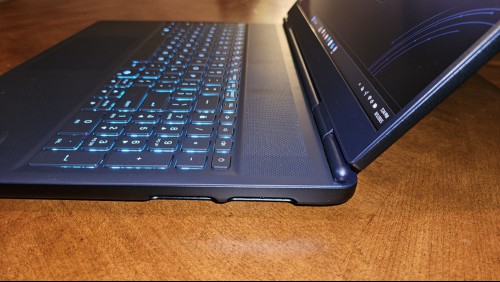
Compared to previous generations of Alienware hardware, the Aurora 16X gaming laptop looks almost modest. Outside of the prismatic alien head adorning the anodized aluminum lid, the Aurora's design is fairly understated, and dare I say, elegant. The dark navy of the chassis, which Alienware has dubbed Interstellar Indigo, shimmers alluringly in the light but fades to a matte black in dimmer settings, while the plastic keyboard deck is a matte version of the same color.
Alienware calls this aesthetic framework AW30, and it extends across the rest of the refreshed Aurora line to also include the 16X's little sibling, the 16. While it's considerably more demure than the "otherwordly" machines that litter Alienware's colorful history, it still retains a few signature touches that make it stand apart from other gaming laptops (my favorite of which is the chamfered front edge, which slopes towards the rear in a smooth curve). There are also what feel like vestigial touches from Alienware's interstellar-themed origins, like its single-zone RGB backlit keyboard. Overall, there are a number of little touches and quality of life improvements over previous generations that make the 16X easy on the eyes, a pleasure to use, and a solid everyday carry.
A little extra in the back
Aside from the streamlined look and slick, rounded edges, one of the first things that struck me as I lifted the 16X out of its packaging was its weight. It's pretty hefty, even for a gaming laptop, coming in at 5.86 pounds. You won't mistake the 16X for an ultraportable, and you'll definitely notice the extra weight tucked into your backpack, briefcase or courier bag.
That said, it's not obnoxiously thick, especially since most of its weight is concentrated in a thermal package perched at the rear of the underside of the bottom deck. This is the key to the 16X's efficient cooling, as it draws cool air in from the underside of the machine to vent through both the back and sides, supplementing the primary fans inside the main chassis without adding undue volume. Because it sits where a footer would normally be included, it doesn't add a tremendous amount of bulk. A musclebook this is not, measuring 0.92 inches at its thickest, 10.45 inches long, and 14.05 inches wide.
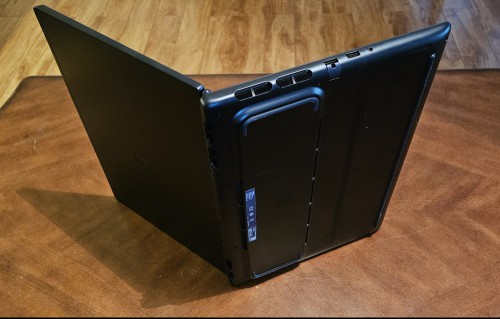
A masterclass in balanced priorities
The Aurora 16X is clearly designed as a gaming laptop first and foremost, with its Nvidia Geforce RTX 5070 GPU (there's also a configuration that comes with the stepdown card, the RTX 5060) and high end Intel Core Ultra 9 275HX processor. That HX designation at the end of the chip's name stands, colorfully, for High-Performance Extreme, indicating that it's one of Intel's most capable mobile processors, which bore out in my benchmarks (more on that later).
More than anything, however, the Aurora 16X is an exercise in harmony. Yes, it sports a capable GPU, but not a high end card like the 5090, which would significantly inflate the price. Its 2560 x 1600, 240Hz IPS display delivers the high refresh rates gamers crave, though not the eye-popping richness and depth of OLED (which would, again, add significant price bloat). Every part of the machine seems intentionally designed to work well with its counterparts while not adding undue cost. It's the definition of a mid-tier laptop, but manages to come in at a price slightly under what you'd expect to pay while examining the spec sheet.

A few corners were cut to keep the price in line; while the lid and bottom deck of the chassis are high quality, anodized aluminum, the keyboard deck itself is plastic, including the touchpad. It's a small downgrade, but noticeable if you've been spoiled by haptic glass touchpads. On the upside, the keyboard itself is broad enough to include a (slightly narrow) number pad, and feels responsive and pleasantly clicky. The keys boast 1.4mm of travel and deliver a premium-feeling typing experience.
A workmanlike display
As I mentioned above, the 16X's display doesn't deliver the wow factor of OLED, with its matchless blacks and vivid whites. But it is an excellent example of what's possible with an IPS LED. The adjective I kept returning to throughout testing was "workmanlike." It's crisp and clear enough, and the 240Hz refresh rate is very welcome, giving you plenty of overhead even in older or less demanding games that may deliver frame rates over 200 fps on this hardware. Perhaps its most impressive feature is its ability to diminish glare. Its 500 nits of brightness, paired with Alienware's anti-glare coating, not only made the 16X a joy to use in brightly lit or outdoor settings, but also delivered fantastic viewing angles. It also benefits from Dell's ComfortView Plus technology, which attempts to limit blue light emission without sacrificing color accuracy.
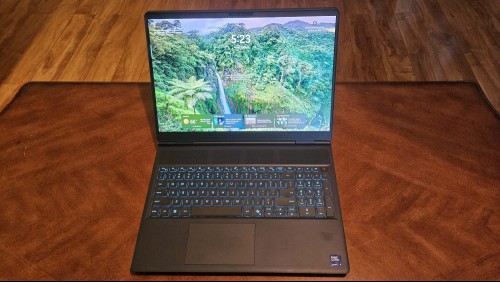
One knock against the display is the thick bezels, particularly the distractingly large lower bezel. The 16:10 resolution is also an interesting choice for a laptop designed primarily for gaming. While the added height gives a little more headroom for browsing or content creation than a standard 16:9 display, I would've traded it for a slightly crisper 3K alternative.
Gaming benchmarks
As a laptop with a discrete GPU designed for gamers, the 16X doesn't disappoint. Even at native resolution and high settings with raytracing cranked up to its highest setting, the 16X delivered an average of 49 FPS in Ubisoft's demanding Assassin's Creed Shadows. For gamers looking for an even more buttery experience, knocking the resolution and graphics presets down a step (to 1920 x 1200 and Medium) pumped the average FPS up to a silky 70+.
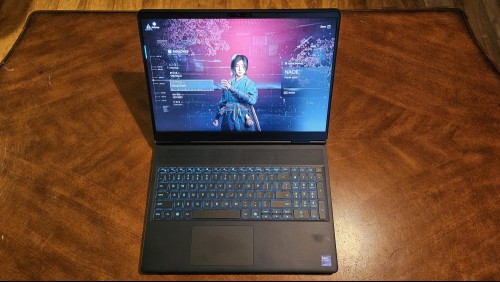
Results were even more impressive in Black Myth: Wukong, the recent action RPG from Chinese studio Game Science. At native resolution on Very High settings and with full raytracing dialed up to Very High, the 16X managed a remarkable 145 average FPS. Black Myth: Wukong is a perfect example of what a great match the IPS panel is for this hardware, given that even a 120Hz panel wouldn't be able to deliver maximum frame rates in this very visually attractive, recent triple-A title.
Productivity benchmarks
Given its workhorse of a central processor, it's no surprise that the Aurora is a productivity superstar as well. In Geekbench 6, it managed sterling scores in both the CPU (Single-core: 2,983; Multi-core: 19,533) and GPU (OpenCL: 133,714; Vulcan: 132,875) tests. These results put it well ahead of higher-priced competitors like the Razer Blade 14, which also packs an RTX 5070 GPU, with a Strix Point processor from AMD standing in for the 16X's Intel Core Ultra 9 275HX. While the single-core CPU and OpenCL GPU (an indicator of general purpose graphics rendering performance) scores were pretty tight, the 16X trounced the Blade 14 in Vulkan GPU (high performance graphics tasks like gaming) and multi-core CPU scores.

While, refreshingly, the AI angle isn't a huge component of Alienware/Dell's marketing push for the Aurora line, the 16X did extremely well in Geekbench AI benchmarks as well. It achieved a single precision score of 6,010, a half precision score of 2,197 and a quantized score of 10,213. These scores also beat the Blade 14's performance, as well as a number of laptops we've recently tested specifically marketed as AI machines, like the MSI Prestige 13 AI+ EVO and Asus Zenbook A14. In fairness, those machines are significantly cheaper than the Aurora 16X, but if you're looking for a laptop with a capable NPU to accelerate AI workloads, the 16X has plenty of horsepower.
The 16X also shows promise for creators, especially those that do a lot of intensive video processing. It was able to transcode a 12-minute 4K video to 1080p in Handbrake in a blistering two minutes and 28 seconds, less than half the time it took the M4-powered MacBook Air (five minutes flat) and over a minute faster than the Razer Blade 14 (at 3:39).
Battery life
While the Aurora 16X packs a massive 6-cell, 90Whr battery, it clearly wasn't designed to serve as an all-day productivity machine. In a standard rundown test, looping video with the display set to 50% brightness (and extras like the keyboard backlighting disabled), the Aurora survived for six hours and 49 minutes. Real world use cases will likely drain it faster, and you're unlikely to get a full work day in without having to top it off at some point, but that's a very impressive result for any gaming laptop with a powerful discrete GPU.
A quality machine for the value conscious
There are other nice touches sprinkled throughout the 16X hardware/software offerings, including a sharp 1080p webcam, a nice selection of ports (two USB-Cs including one Thunderbolt 4, two USB-As, combo audio, HMDI 2.1 and Ethernet; sadly, a Micro-SD slot is absent) and a Stealth Mode setting that slashes hardware performance to eliminate virtually all fan noise.
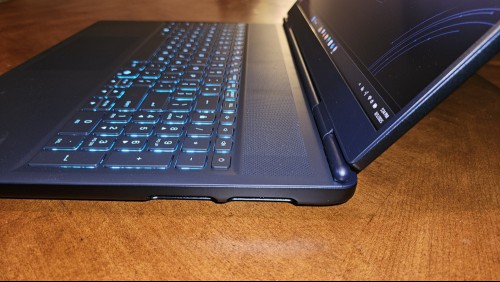
The entire package presents as a near-ideal mid-tier laptop. It's a delight to use, offers excellent performance and a reasonable display, and comes in with a fair price at two grand (down to $1,800 at time of writing). That's an excellent value for what's on offer given how well it's executed, especially because you can get less powerful configurations than the one I tested starting at $1,560 (down to $1,450 at time of writing), and if you want to step down even further you can get the Alienware Aurora 16 (without the X) starting for $1,500 (down to $1,300 at time of writing). While it doesn't truly excel in any one category, it's very strong across the board: A true jack of all trades, master of none in the gaming laptop space.
Alan is an experienced culture and tech writer/editor with a background in newspaper reporting. His work has appeared in Rolling Stone, Paste Magazine, The Escapist, ESPN, PC Gamer, and a multitude of other outlets. He has over twenty years of experience as a journalist, author, and editor. His debut novel, The Sixth Borough, is available now.
